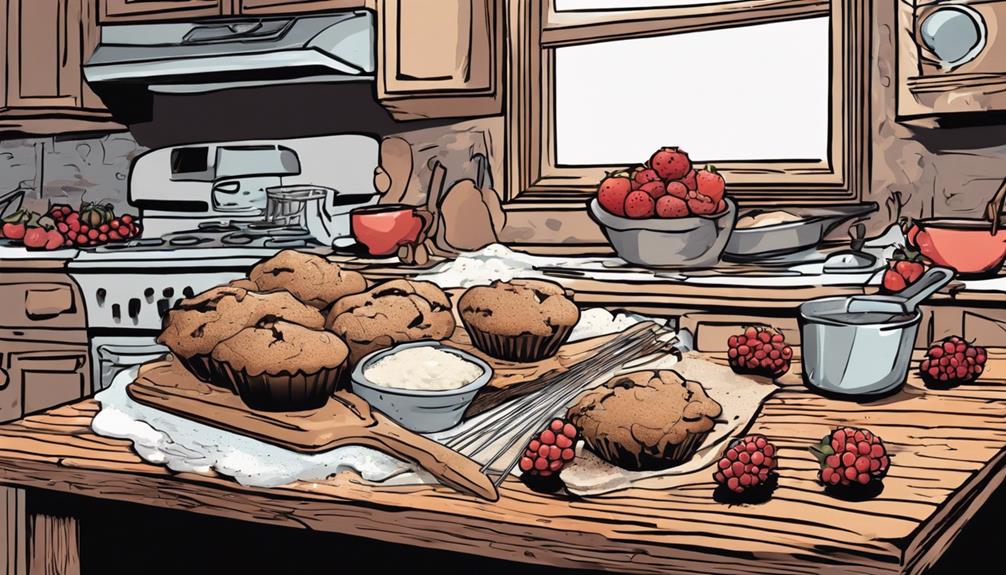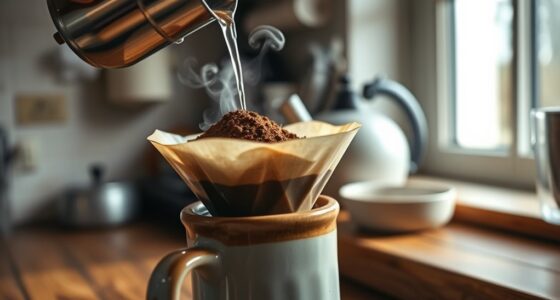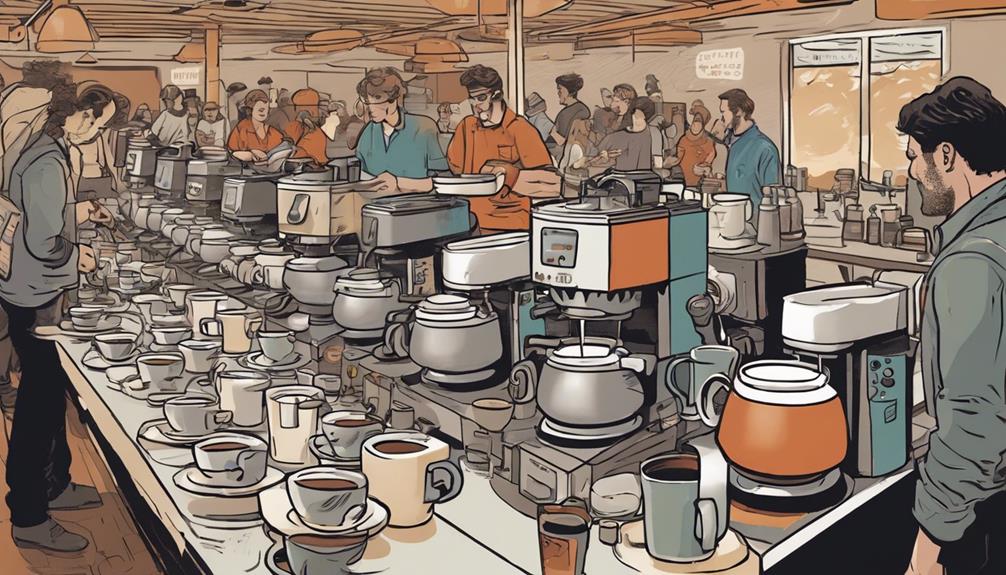Get ready to indulge in a delightful experience with coffee cookies! Begin by preheating the oven and mixing together flour, baking soda, and salt. Cream together butter and sugar, then mix in eggs, vanilla, and chocolate chips. Allow the dough to chill. Once you take a bite, you’ll be in for a heavenly combination of coffee and cookie flavors.
Key Takeaways
- Use fine instant espresso powder for intense coffee flavor.
- Ensure all ingredients are at room temperature for optimal dough consistency.
- Chill dough before baking to prevent cookies from spreading.
- Balance coffee strength and chocolate chips for a harmonious taste.
- Store cooled cookies in an airtight container for lasting freshness.
Ingredients
When making coffee cookies, gather your butter, sugar, eggs, flour, chocolate chips, and coffee flavoring as the key ingredients.
To infuse your cookies with a rich coffee taste, consider using instant espresso coffee or espresso powder.
The butter plays a vital role in creating a soft and moist texture for your cookies.
For a delightful burst of sweetness, choose chocolate chips that complement the coffee flavor – whether you opt for semisweet, dark, or milk chocolate.
The espresso powder adds a deep coffee undertone that enhances the overall flavor profile of your cookies.
When measuring out your ingredients, precision is essential to achieving the perfect balance of flavors.
Whether you experiment with dairy-free butter, gluten-free flour, or vegan egg substitutes, make sure that you maintain the integrity of the cookie's texture and taste.
Recipe Steps
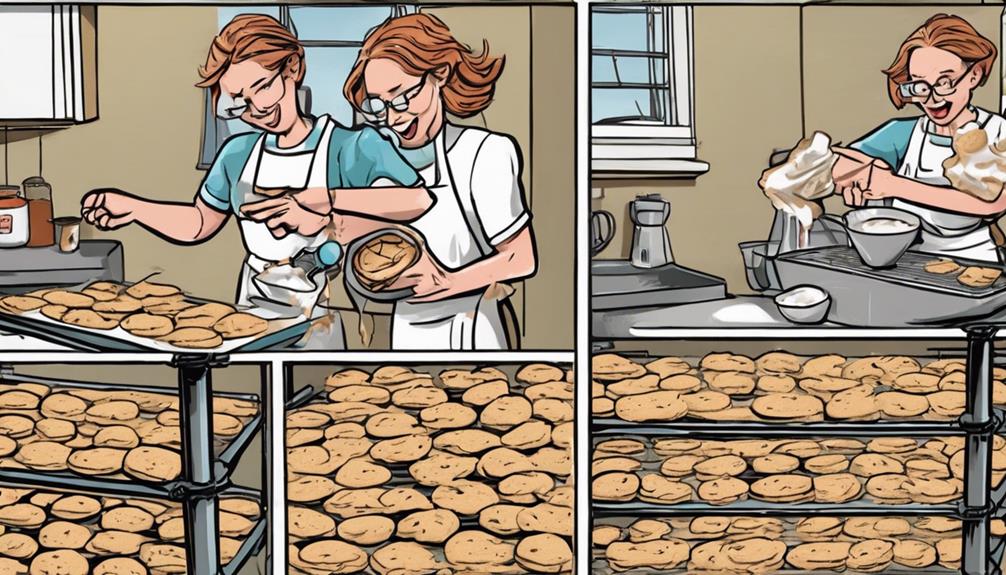
Now that you have your ingredients ready, let's talk about the recipe steps.
The STEPS we'll cover include the baking process overview, essential ingredient details, and handy baking tips and tricks to guarantee your coffee cookies turn out perfect.
This discussion will guide you through each step, making the baking experience smooth and enjoyable.
Baking Process Overview
Begin by preheating the oven to the specified temperature and lining baking sheets with parchment paper to prepare for making chewy coffee cookies.
While the oven preheats, whisk together flour, baking soda, and salt in a separate bowl to prepare the dry ingredients for the cookie dough.
In another bowl, cream together butter and sugars until light and fluffy. Then, add eggs and vanilla extract to create a rich and flavorful base for your cookies.
Gradually incorporate the dry ingredients into the wet mixture, making sure everything is well combined. Don't forget to mix in semisweet chocolate chips for that extra touch of sweetness and decadence.
Once the dough is ready, chill it in the refrigerator to help the flavors meld and the texture firm up.
After chilling, portion the dough into cookie dough balls and place them on the prepared baking sheets.
Bake the cookies until the edges are set and golden brown.
Enjoy your delicious homemade coffee cookies straight from the oven!
Essential Ingredient Details
For the best results, it's crucial that your butter and eggs are at room temperature before starting the coffee cookie recipe. When preparing your coffee cookies, keep in mind these vital ingredient details:
- Instant Espresso Powder: Infuse your cookies with a rich coffee flavor by using instant espresso coffee or espresso powder.
- Chocolate Chips: Add a delightful chocolatey element to your cookies by incorporating chocolate chips into the dough.
- Room Temperature Ingredients: To ensure proper mixing and texture, it's vital to use ingredients like butter, eggs, and sugars at room temperature.
- Vanilla Extract: Enhance the overall flavor profile of your cookies with the addition of vanilla extract.
- Dark Brown Sugar and Granulated Sugar: Achieve the perfect balance of sweetness and depth of flavor by combining dark brown sugar and granulated sugar in the recipe.
Following these ingredient details will help you create delicious coffee cookies that are packed with flavor and texture.
Baking Tips and Tricks
To achieve perfect coffee cookies, make certain you preheat the oven and line your baking sheets for even baking and easy cleanup. Whisk together dry ingredients like flour, baking soda, and salt to guarantee proper distribution in your cookie dough. When creaming the butter and sugars, beat them until light and fluffy before adding eggs and vanilla for a rich base. Gradually incorporate the flour mixture into the wet ingredients, mixing only until just combined to avoid overworking the dough. Remember to chill the cookie dough before portioning and baking to maintain the cookies' shape and texture. Here's a handy table summarizing these essential baking tips for your coffee cookie recipe:
| Baking Tip | Description |
|---|---|
| Preheat oven and line baking sheets | Ensures even baking and easy cleanup |
| Whisk dry ingredients together | Properly distributes flour, baking soda, and salt in the dough |
| Cream butter and sugars before adding wet ingredients | Creates a light and fluffy base for the cookies |
Baking Instructions
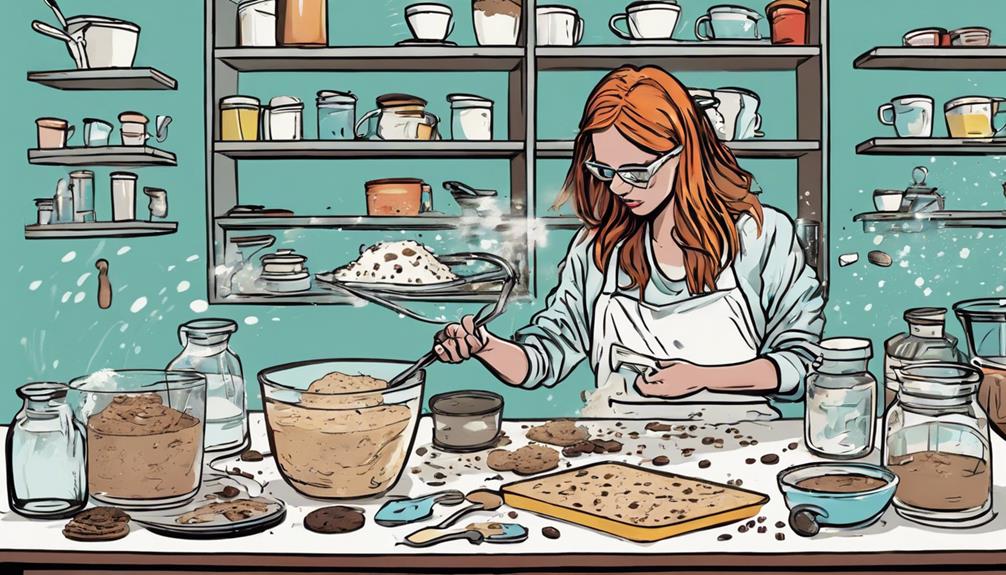
Mix the prepped dry ingredients into the butter and sugar mixture until well combined. Once you have achieved a smooth dough, follow these baking instructions for perfect coffee cookies:
- Preheat the Oven: Verify your oven is set to the specified temperature for the coffee cookies recipe to guarantee even baking.
- Whisk Dry Ingredients: Whisk the dry ingredients together, making sure the espresso powder is evenly distributed for a balanced flavor.
- Cream Butter and Sugars: Cream the butter and sugars until light and fluffy to create a delightful texture in your cookies.
- Chill the Dough: Before baking, chill the cookie dough to prevent spreading and maintain a chewy consistency.
- Portion Uniform Balls: Portion the dough into uniform balls to secure consistent baking results and evenly sized cookies.
Expert Tips
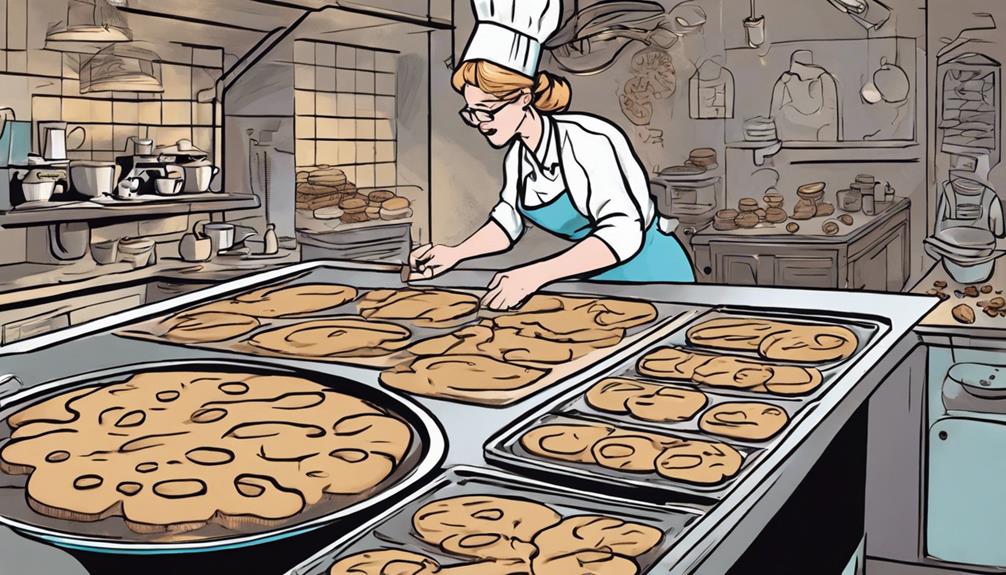
When baking coffee cookies, remember to measure flour accurately for the perfect texture.
Use a maximum of 1.5 tablespoons of espresso to enhance the coffee flavor.
Be cautious not to over-mix the dough to maintain a soft and chewy consistency.
Baking Techniques
For superior coffee cookies, guarantee accurate flour measurement for the best texture. Properly measuring flour by spooning it into the measuring cup and leveling it off ensures your cookies turn out just right.
Chill your cookie dough for at least 30 minutes before baking to prevent flat cookies and maintain a chewy consistency.
Using room temperature ingredients like butter and eggs aids in better incorporation and texture of your coffee cookies.
Don't forget to check the expiration date of your baking soda to ensure proper leavening and rising of the cookies.
Lastly, opt for fine instant coffee or espresso powder to enhance the coffee flavor in your cookies.
- Properly measure flour: Spoon flour into the measuring cup and level it off for the ideal texture.
- Chill cookie dough: Refrigerate the dough for at least 30 minutes to prevent flat cookies.
- Room temperature ingredients: Use butter and eggs at room temperature for better texture.
- Check baking soda: Ensure the baking soda isn't expired for proper leavening.
- Use fine coffee powder: Opt for fine instant coffee or espresso powder to enhance the coffee flavor.
Flavor Enhancements
To elevate the coffee flavor in your cookies, consider incorporating brewed black coffee, dry coffee granules, or espresso powder as expert tips for enhancing the taste profile.
By using brewed coffee or coffee extract instead of vanilla extract, you can achieve a more robust coffee taste in your cookies.
Experimenting with different types and flavors of coffee allows you to personalize the taste of your coffee cookies to your liking.
Instant coffee can be a convenient option to make brewed coffee for your recipe, while espresso powder provides a more concentrated coffee flavor.
These various coffee options and flavorings offer a range of possibilities to enhance the coffee profile in your cookies, catering to your individual preferences.
Don't be afraid to get creative and play around with different coffee elements to create a truly delightful coffee cookie experience.
Storage Guidelines
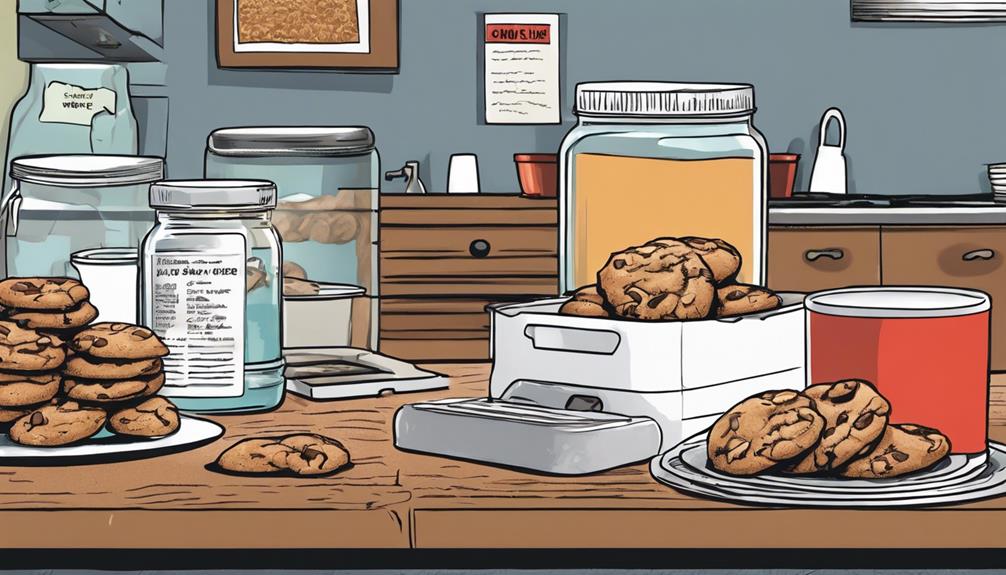
Properly storing coffee cookies is essential for preserving their taste and texture. To safeguard your coffee cookies stay fresh and delicious, follow these storage guidelines:
- Cool Before Storing: Allow your coffee cookies to cool completely before storing them. This helps uphold their texture and prevents them from becoming soggy.
- Airtight Container: Store your baked coffee cookies in an airtight container. This helps prevent moisture from seeping in and keeps the cookies from drying out.
- Refrigerate Unbaked Dough: If you have leftover unbaked coffee cookie dough, refrigerate it to maintain its quality and prevent it from spoiling.
- Reheat for Warm Treats: When you're ready to enjoy a warm coffee cookie, simply pop it in the oven for a quick reheat.
- Freeze Unbaked Dough: For future use, freeze unbaked coffee cookie dough. This way, you can have freshly baked cookies whenever you desire.
Additional Cookie Recipes

You can expand your baking repertoire with a variety of cookie options and discover new baking techniques.
Try out Funfetti Sugar Cookies, Snickerdoodle Cookies, or Chocolate Chip Pretzel Cookies for different flavor profiles.
Experiment with unique recipes like Vegan Peanut Butter Chocolate Chip Cookies or White Chocolate and Raspberry Cookies to add a twist to your classic cookie lineup.
Cookie Variety Options
Explore a diverse selection of cookie recipes, including Vegan Peanut Butter Chocolate Chip Cookies and Strawberry Cheesecake Cookies, to add excitement to your baking repertoire. These additional cookie recipes offer a range of flavors and textures, perfect for various preferences and occasions.
Each recipe puts a unique spin on the classic cookie, bringing creativity and diversity to your baking endeavors. Trying out these different cookie options can be a fun way to discover new tastes and techniques in the kitchen.
Experimenting with a variety of cookie recipes not only allows you to find your personal favorites but also gives you the opportunity to share delicious treats with your loved ones.
- Vegan Peanut Butter Chocolate Chip Cookies
- Strawberry Cheesecake Cookies
- White Chocolate and Raspberry Cookies
- Snickerdoodles Without Cream of Tartar
Each recipe provides a unique twist on classic cookies.
Baking Techniques Highlighted
For enhanced flavor and texture in your coffee chocolate chip cookies, consider incorporating fine instant coffee or espresso powder as the primary ingredient. These baking techniques will infuse your cookies with a robust coffee flavor while adding a subtle richness that complements the chocolate chips perfectly.
To achieve a chewy texture, make sure all your ingredients are at room temperature before mixing them together. This step helps create a uniform dough that spreads evenly during baking, resulting in soft and chewy cookies with every bite.
Experiment with different types of coffee to customize the flavor profile of your cookies. Whether you prefer the intensity of brewed black coffee or the convenience of dry coffee granules, each option offers a unique twist to your recipe.
Additionally, proper storage techniques, such as placing the cookies in an airtight container, will help preserve their freshness for 3-5 days, allowing you to enjoy these delectable treats longer.
Don't forget that ingredient substitutions like espresso powder for ground coffee or unsweetened applesauce for eggs provide versatile alternatives to accommodate various dietary preferences.
Video Tutorial

The engaging video tutorial vividly illustrates the process of baking delectable coffee cookies. As you watch the tutorial, you'll see:
- The step-by-step instructions for creating delicious coffee cookies.
- The importance of proper flour measurement and how it impacts the texture of your cookies.
- Tips on using coffee in your cookie recipe to enhance the flavor.
- Suggestions for ingredient substitutions to customize the cookies to your liking.
- Guidance on storage techniques to keep your coffee cookies fresh and flavorful.
Nutritional Information
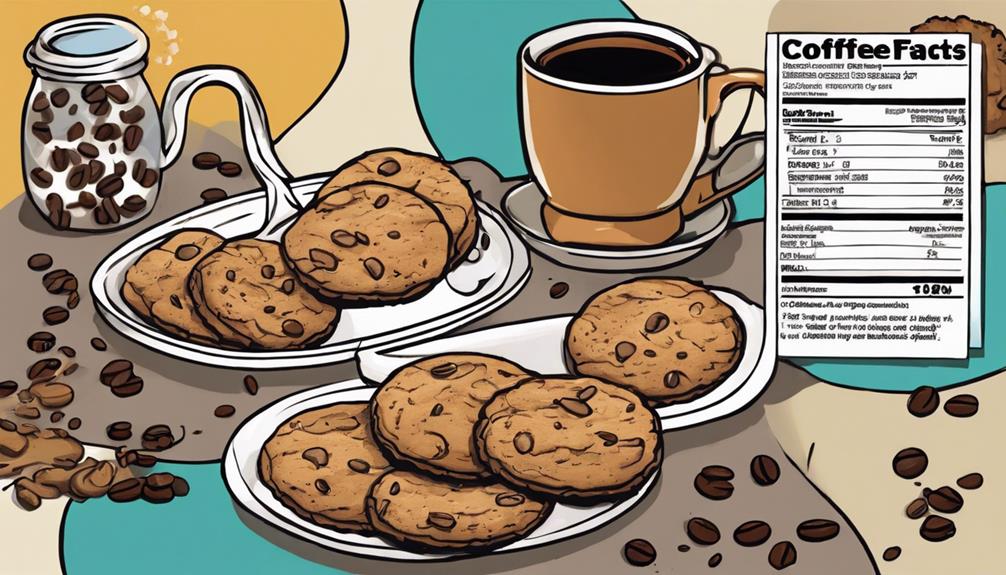
Discover the nutritional content of these delightful coffee cookies to make informed choices about your consumption. One serving of these coffee cookies contains approximately 229kcal, making it a moderate-calorie treat.
Concerning carbohydrates, each serving packs around 36g, providing a source of energy. If you're looking to boost your protein intake, these cookies offer about 4g per serving.
Regarding fat content, expect around 8g, which contributes to the rich texture of the cookies. Additionally, the sodium levels in these coffee cookies are approximately 98mg per serving.
Being aware of the nutritional information can help you balance your diet and enjoy these coffee cookies in moderation. Remember that moderation is key when indulging in treats like these, especially if you're keeping an eye on your calorie and carbohydrate intake.
Ingredient Variations
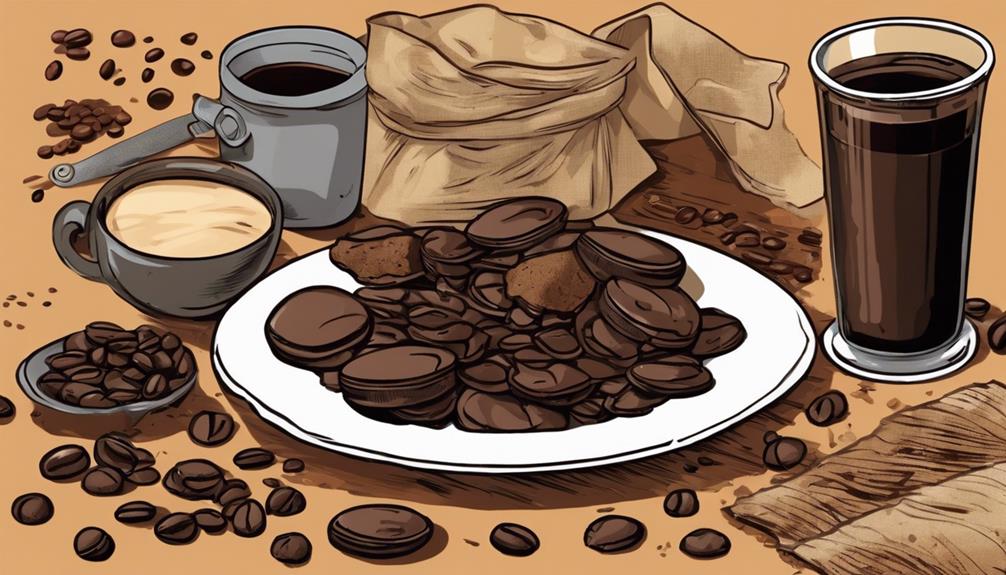
Consider experimenting with different ingredient variations to customize your coffee cookies according to your preferences and dietary needs. Here are some options to tailor your recipe:
- Espresso Powder: Choose between regular or decaf espresso powder to adjust the coffee intensity in your cookies.
- Dairy-Free: Opt for dairy-free or vegan butter as an alternative for those with dietary restrictions.
- Egg Replacer: Swap out eggs with a flax egg for a vegan-friendly version of the recipe.
- Flour Choices: Select between all-purpose flour or gluten-free flour to cater to gluten sensitivities.
- Chocolate Chip Selection: Personalize your cookies by using semisweet, milk, or dark chocolate chips based on your taste preferences.
Taste and Texture
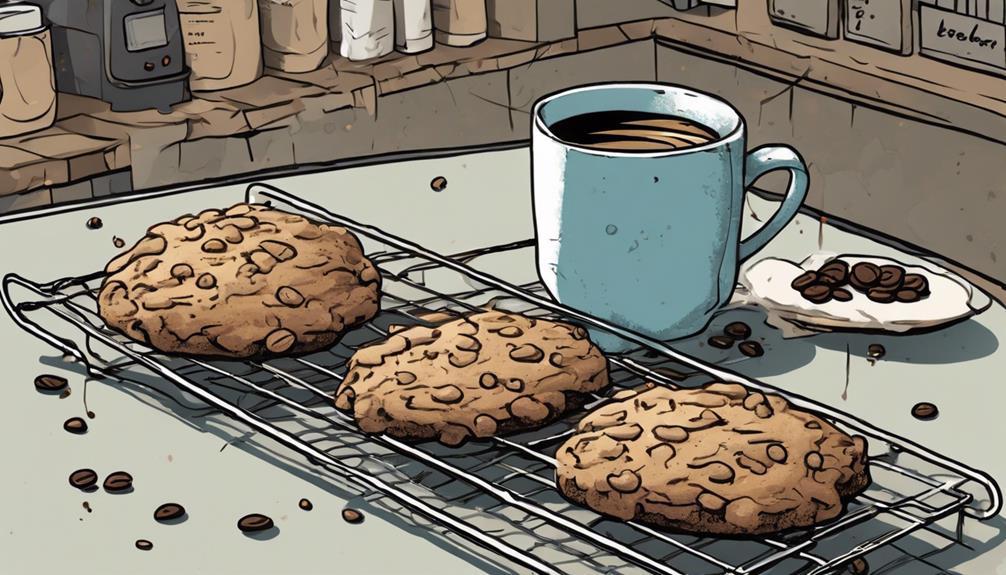
For best flavor and texture in your coffee cookies, adjusting the coffee strength and experimenting with different ingredients can enhance your baking experience. When aiming for a chewy texture, consider the balance of coffee flavor and chocolate chips in your cookies. The sweet, buttery taste of the cookie combined with the rich coffee infusion creates a delightful treat. Here's a table to help you understand the importance of each component:
| Texture | Coffee Flavor | Chocolate Chips |
|---|---|---|
| Chewy | Robust | Complementary |
| Soft | Rich | Optional |
| Moist | Balanced | Enhancing |
| Delicate | Aromatic | Varied |
Experimenting with instant espresso powder or brewed coffee can intensify the coffee flavor. Additionally, chilling the dough before baking guarantees the cookies maintain their shape, resulting in a perfect chewy consistency. If you want to emphasize the coffee flavor, try omitting the chocolate chips for a unique twist on your coffee cookies.
Frequently Asked Questions
What Is the Golden Rule in Baking Cookies?
Avoid overmixing the dough when baking cookies to prevent toughness. Properly measure flour for ideal texture. Chill the dough to control spread. Use room temperature ingredients for consistent results. Follow recommended time and temperature for perfect cookies.
How to Bake Packaged Cookies?
Preheat your oven to the recommended temperature on the cookie package for even baking. Place the pre-portioned cookie dough on a parchment-lined baking sheet to prevent sticking. Follow the suggested baking time provided for perfectly baked cookies.
How Do You Bake Cookies in Minecraft?
Just like a warm hug on a chilly day, baking cookies in Minecraft is a comforting experience. Combine two wheat and one cocoa bean to craft a cookie. Enjoy restoring hunger points and feeding parrots!
How to Use Oven for Cookies?
To use an oven for cookies, preheat it to the specified temperature, line baking sheets with parchment, place cookie dough on them, rotate sheets halfway through baking, follow recommended time, and let cookies cool on sheets.
Conclusion
Indulge in the rich flavors of coffee cookies, where each bite is a taste of heavenly goodness.
Let the warm aroma of freshly baked treats fill your home, creating a cozy and inviting atmosphere.
These cookies are perfect for sharing with loved ones or enjoying a quiet moment with a cup of coffee.
Embrace the simple pleasure of baking and savoring these delectable cookies – a true delight for the senses. Looking for a new recipe to try? Look no further than this coffee biscuits recipe. These cookies are perfect for a mid-afternoon pick-me-up or a cozy late-night snack. The aroma of coffee combined with the sweet, buttery taste of the cookies is sure to make them a hit with anyone who tries them. So gather your ingredients and get ready to enjoy the simple pleasure of baking and savoring these delectable coffee biscuits.

